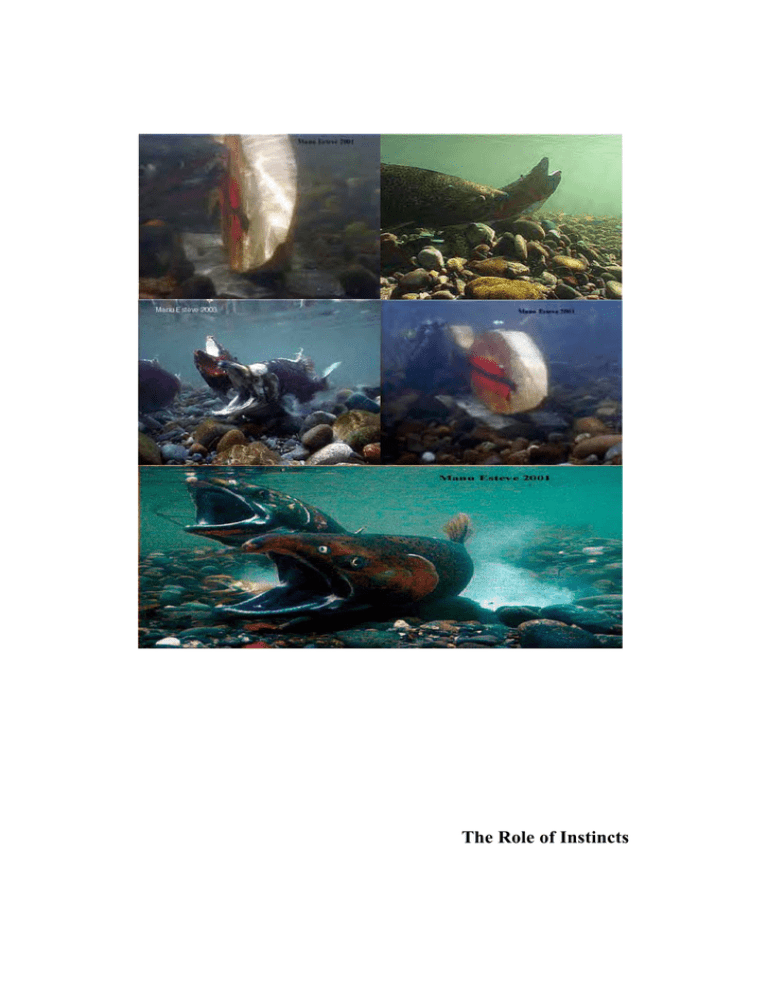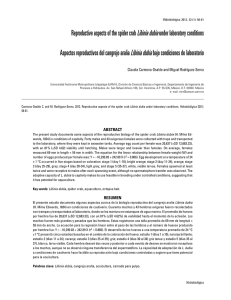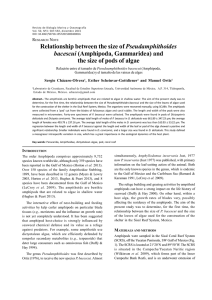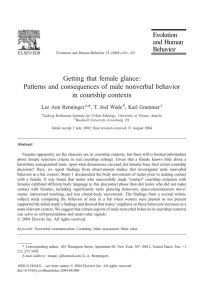The Role of Instincts
Anuncio

The Role of Instincts Chapter 3: The Role of Instincts 51 3. The Role of Instincts Introduction An instinct can be defined as a distinctive behaviour, which can be repeated over and over, given the right external stimuli and the individual’s internal motivation. Instincts do not depend of any previous experience and are carried out in the same way by all individuals of one species (Lorenz, 1932). The salmonines complete spawning process can be understood as a long chain of interrelated instincts that run in increased intensity leading to gamete release. Experimental work in the first half of the last century disclosed the general mechanisms by which instinctive actions are completed (Lorenz, 1932 & 1935; Tinbergen, 1942 & 1948). Instincts are elicited every time individual motivation has reached a certain physiological threshold level. The threshold varies with time and with the number and intensity of the stimuli received. If for a long period of time an instinctive action is not brought to a release, the threshold sinks. In some cases it may disappear, and then the instinctive action is released by itself without any external stimuli. Additionally, the stimuli are additive and the threshold is reached quicker when their number and intensity is high (Tinbergen, 1948). As soon as an instinctive action has been released the threshold goes up again, so that further stimuli are required in order to start the action over (Fabricius, 1950). However, before this stimulusreaction chain begins a certain motivation has to exist. In the salmonines case, rising of the internal motivation is induced by hormones, which in turn are influenced by physical variables, with photoperiod the most important (Power, 1980). A few experiments have recognized some of the key stimuli necessary for salmonines to perform different behaviours. Fabricius & Gustafson (1954) showed that visual stimuli alone are able to elicit exploring and digging behaviours in arctic charr. This they did by introducing a mature female in an aquarium after placing a glass plate over a section of gravel. The female was seen performing normal exploring and digging behaviours over the glass, even though she had no physical contact with the gravel, nor a male courting her. Hartman (1970) identified ‘egg release’ as a strong stimulus for covering digs. A rainbow trout female chassed away from her nest right after spawning was observed digging twice Chapter 3: The Role of Instincts 52 about 2 m from her nest in about 10 seconds. Tautz & Groot (1975) identified nest depth and structure as important stimuli inducing oviposition. The authors artificially built a depression the shape of a nest in an enclosed channel. When a mature and unspawned female was directed to the area they saw that the number of diggings bouts, she completed before ovipositing on that nest, was substantially less than the average required to build a new nest (75 vs. 255). This chapter further investigates the role instincts have in the salmonines reproductive behaviour. Firstly, two salmon dummies were built to investigate the necessary stimuli to induce some male behaviours. Secondly, data was used to discuss two behaviours relatively unknown: false spawnings in females and digging behaviour in males. Chapter 3: The Role of Instincts 53 Methods Two fish dummies imitating a female were built in order to investigate the necessary stimuli inducing three male mating behaviours: tasting, quivering and sperm release. Dummy one A fish-shape wooden dummy was build to test if its presence on the spawning grounds was enough to elicit the male quiverings and tastings (see Chapter 2). The dummy had an attached lead platform that allowed it to remained in a stationary position over the salmon redds (Figure 1). Dummy one was used in two one-hour trials with wild chum salmon at the Big Beef Creek Spawning Channel, WA (for a description of the spawning channel see Schroder, 1973). It was located in random locations in a 50-meter section of the channel in where male and females had free access. No attempts to separate males and females were made. The trials were performing during morning hours (10:00-12:00). Observations were recorded for later analysis and discussion. The following hypotheses were tested: Ho1: A stationary body, the shape of a fish, remaining motionless over the gravel does not induce male quivering behaviour. Ho2: A stationary body, the shape of a fish, remaining motionless over the gravel does not induce male tasting behaviour. Dummy two A dummy imitating the spawning act posture of the female was build to study what are the necessary stimuli inducing male sperm release. Dummy two (named Mesalina) was designed based on a female chinook salmon bought from a local market. The fish was immersed in a box with plaster, to produce a negative mold. The “typical” probing and spawning position (see Chapter 2) was forced on the fish during the curing process of the plaster. Once the plaster was cured, the mold was cut with a band Chapter 3: The Role of Instincts 54 saw into two longitudinal pieces. The mold was cleaned and liquid latex casting compound was poured into it. Once dry, both sides were glued together with the same mix, leaving an abdominal cavity to hold a silent underwater vibratory device (150 Hz). The pink color of the mix was replaced by a white cream colour in the belly and a mixture of red and dark green in the upper body (Figure 2). Three different types of trials were made with Mesalina. In the first one, the dummy remained motionless in the gravel (type 1). In the second the Mesalina contained a silent underwater vibrational device that made her vibrate at a high frequency (150 Hz) but not perceptible amplitude (type 2). In the third, a rod with a line attached to its tail made Mesalina to vibrate at a lower frequency (4-7 Hz.) and high amplitude (type 3). Mesalina was used in seven one-hour trials; one hour (type 1) with wild chum and coho salmon at the Big Beef Creek Spawning Channel (WA). Two hours (type 2) with wild chinook salmon at the Yakima River (WA). Four hours (2 hours type 2 and two hours type 3) with wild sockeye salmon at the Cedar River (WA). In all the trials Mesalina was located in random locations over spawning gravel in where males and females had free access. Observations were recorded for later analysis and discussion. The following hypotheses were tested: Ho3: A stationary body, the shape of a fish, imitating the ovipositing posture of a female (type 1) does not induce male sperm release. Ho4: A body the shape of a fish, imitating the ovipositing posture of a female and provided with a vibratory device of no perceptible amplitude and very high frequency (type 2) does not induce male sperm release. Ho5: A body the shape of a fish, imitating the ovipositing posture of a female with a visibly trembling movement (type 3) does not induce male sperm release. Chapter 3: The Role of Instincts 55 Figures 1 & 2. Dummies 1 (left) and Mesalina (right). The methods for investigating false spawnings in females and male diggings are included in the two case studies at the end of this chapter. Chapter 3: The Role of Instincts 56 Results and Discussion Use of dummies The use of dummies in animal behaviour research is based on the idea that under certain conditions a stimulus alone can release an instinct, and consequently an instinct can be released by an irrelevant object with one or some of the required characteristics (Lorenz, 1935). There is a long tradition of using dummies for better understanding the salmonines spawning patterns (Fabricius & Gustafson, 1954; Newcombe & Hartman, 1980; Satou et al., 1987; Takeuchi et al., 1987; Satou et al., 1991; Satou et al., 1994; Craig & Foote 2001). During our two hour observations with dummy one we were not able to elicit male quivering behaviour (Ho1 non rejected). Nevertheless, dummy one elicited three tastings (by three different males) during that period (Figure 3; Ho2 rejected). In addition, several times males collocated themselves parallel to the dummy maintaining the characteristic guarding position (Figure 4). Figures 3 & 4. A chum salmon male tasting (left) and guarding (right) dummy one. The fact that dummy one didn’t elicited quiverings contradicts our previous findings, as we have seen on numerous occasions Atlantic salmon males performing quiverings to our underwater camera (Table 2 in Chapter 2; the camera remains motionless in the gravel inside a rectangular housing see Figure 2 in Chapter 2). Probably the lack of quivers as well as the low incidence of behavioural responses to dummy one was the result of the presence of real Chapter 3: The Role of Instincts 57 females in the same waters the dummy was located. An alternative explanation is that there are species more prone to response to dummies, or to stimuli in general, than others. Most likely, species, as Atlantic salmon, traditionally spawning in lower densities are more prone to respond to any stimuli due to the limited availability of spawning females. In our first trial (type 1) with Mesalina, no chum or coho male released sperm, indicating that visual stimuli alone are not enough to elicit male sperm release (Ho3 non rejected). In addition, no male was seen to perform quivers to the dummy. This, agree our findings with dummy one. The reasons are probably the same ones discussed above (presence of real females and/or differences in species responses to dummies). In the second trial (type 2) Mesalina did not elicited sperm release in chinook or sockeye males (Ho4 non rejected). This indicates that the sum of visual plus high frequency vibrational clues is not enough to elicit male sperm release. However, the vibration frequency employed (150 Hz) was probably too high to influence the males’ behaviour (Satou et al 1994 reported frequencies of 32 Hz for the spawning act of sockeye salmon). Mesalina; however elicited four quivers in one chinook male in the Yakima River. The fact that no quivers were elicited with sockeye males supports the idea of a difference in the response to stimuli between species spawning in high or low densities. In the third trial (type 3) Mesalina elicited 49 sperm emissions from at least five different sockeye males in the Cedar River (Figures 5 & 6; Ho5 rejected). The fact that the same dummy, when remaining motionless, was not able to induce any sperm release (in the same males) indicates that visible vibration may be a necessary stimulus for males to spawn. This confirms experiments done by others (Satou et al., 1987). Overall our results, have shown that a combination of visual and vibrational clues elicit males’ sperm release. However, stationary dummies have also induced male’s sperm release (Foote pers. com.). This, together with the fact that Mesalina has only worked for some males (supposedly the most motivated ones) confirms the role ‘high motivation-low threshold’ plays. Chapter 3: The Role of Instincts 58 Figures 5 & 6. Sockeye males release sperm to a dummy imitating an ovipositing female. The motivation-stimuli process described exists for all behaviours. This includes the ones belonging to the fighting drive (for a discussion about mating and fighting drives see Hinde, 1953). We can thus, refer to stimulus for escaping, motivation to attack and so on. Salmoninae males establish territories around nesting females. It has been reported that prior residence mostly determines the success of a territorial dispute (Foote, 1990; Healey & Prince, 1998; Morbey, 2002). The logic of this paradox can be explained if we admit that prior residence confers a differential motivation-threshold stage to the individual. A permanently guarding male may experience, due to a continuing state of tension, higher motivation and lower threshold for attacking. As a result, even when two hypothetical contenders have a similar size (and thus the stimulus provided by each other is about the same) differences in motivation-threshold may result, most of the times, in the victory of the resident fish. Finally, the fact that a low intensity stimulus can release an instinct when the motivation is high may explain, in some cases, why hybridization occurs (Table 1, Figure 7). In the extreme, a female could be so motivated to spawn that she can expel her eggs without any males present (Fabricius, 1953 for arctic charr; Gaudemar & Beall, 1998 for Atlantic salmon). Chapter 3: The Role of Instincts 59 Table 1. References of hybridizations within Salmoninae species. Species References Brook trout female with brown trout male (Kitano et al., 1994; Groot, 1996; Grant et al., 2002) Chinook female with sockeye male (per. observations, Table 2 in Chapter 2) Coho female with cutthroat male (per. observations, Table 2 in Chapter 2) Atlantic salmon female with brown trout male (per. observations, Table 2 in Chapter 2) Brown trout female with Atlantic salmon male (Gephard et al., 2000) Rainbow trout with cutthroat trout (Henderson et al., 2000) Pink female with masu male (Maksimovich & Frolov, 2002) Brook trout with Lake trout (Berst et al., 1981) Brook trout with bull trout (Kitano et al., 1994) Figure 7. A cutthroat male (pointed by the white arrow) releases sperm during a coho pair spawning act Chapter 3: The Role of Instincts 60 Two case studies: false spawnings in females and male digging The instinct paradigm helps explain the existence of several little known behaviours in breeding salmonines. Here I use data from underwater recordings to discuss two of these behaviours, false spawnings in females and digging behaviour in males. False spawnings Salmoninae females will often perform a behaviour identical to the spawning act, but without releasing eggs (Figures 6 & 7, discussed in Chapter 2). This behaviour known as false spawning is common to all the salmonines (Table 2 in Chapter 2). Fig. 6 & 7. The same pair of Atlantic salmon during false (left) and real spawning (right). It has been suggested that false spawning is a form of female choice by which females trick undesirable males. According to this, females mimic the spawning act to fool their mates into sperm release and wait for a more desirable male to spawn with. However, several facts make this idea unlikely. First, as stated by Tinbergen (1952a) instinctive activities may be seen in numerous degrees of intensity, from full intensity down to an almost imperceptible indication of it. I have seen on many occasions the same female performing false spawnings of different increasing intensities before ovipositing. This includes a probing lasting 1-2 seconds while partially gaping to total spawning mimics including trembling and fully gaping over 5 seconds. A Chapter 3: The Role of Instincts 61 false spawning thus may be a low intensity behaviour produced because at the last moment females don’t reach the threshold level to release their eggs. Second, as demonstrated by Tautz & Groot (1975) nest depth is a strong stimulus for females to spawn. False spawnings could be occurring when at the last probing females feel the nest condition is not good enough to trespass the threshold inducing oviposition. This idea agrees with Jones & Ball (1954) when they suggested that false spawnings occur because the female, at the very last minute, finds that the nest is not suitable for oviposition. In order to test these two competing hypotheses (female choice vs. incomplete stimuli) I used underwater video recording data of 18 false spawnings performed by 10 different females (Table 2). In all cases, females were finally seen to actually spawn some minutes after the false spawning (0.5-16 minutes, N=18). Table 2. False spawning history from 10 different females. The occurrence of diggings and change of mate between false and real spawnings is indicated. Species n Fs Female 1 Atlantic salmon 1 yes no Female 2 Sockeye 3 yes, yes, yes no, no, no Female 3 Sockeye 1 yes no Female 4 Sockeye 2 yes, no no, no Female 5 Chum 1 yes no Female 6 Coho 5 yes, yes, yes, yes, yes no, no, no, no, no Female 7 Coho 1 yes no Female 8 Coho 1 no no Female 9 Pink 2 no, no no, no Female 10 Chinook 1 yes no 18 14 0 total diggings change of mate n Fs: number of false spawnings If it were true that females perform a false spawning because of nest incompleteness we should expect diggings after the false spawning. Contrary, if females were mimicking spawning just to fool their mates we should expect they would change their mate in the real spawning. A null hypothesis stating that females do not dig after a false spawning was rejected using Binomial distribution test (p= 0.5, P-value = 0.011, Table 3). Other than nest readiness the Chapter 3: The Role of Instincts 62 stimulus females need for ovipositing is probably the one provided by the male. An insufficient male stimulus may indeed explain the cases where females did not dig their nest. A null hypothesis stating that females change their mate after false spawnings was also rejected (p= 0.5, P-value <0.001, Table 3). These two facts (diggings after spawning and mate fidelity) make the incomplete stimuli hypothesis most probable. Table 3. females digging and change of mate after a false spawning. not digging digging same mate different mate expected 9 9 9 9 observed 4 14 18 0 However, in nine out the eighteen observed cases the female ended spawning with the prior mate plus one or more additional males. False spawnings thus seems to have an effect increasing the final number of mates. This agrees with Schroder (1981) stating that by performing false spawnings females provide cues to males in the vicinity about immediate spawning. By increasing the number of mates females increase either the genetic diversity of their offspring or the quality of the participating males (Petersson & Järvi, 2001 for brown trout). As a conclusion false spawnings are low intensity behaviours produced when females do not receive enough stimuli (from their nest or their mate) for oviposition. This behaviour has probably been maintained in the evolutionary course because of its adaptive value due to an increase in the final number of mates. Male diggings as displacement reactions Oncorhynchus males dig during the spawning process (Figures 8 & 9, Table 4). However, male salmon digging has not been understood as a nest building behaviour. It has been considered to be an aggressive display and several authors have linked it with male-male aggression (Chebanov, 1980 for pink salmon, Healey & Prince, 1998 for coho salmon, Quinn, 1999 for sockeye & chum salmon). Chapter 3: The Role of Instincts 63 Figures 8 & 9. Sockeye salmon’ male digging behaviour. Table 4. Presence or absence of male digging in Oncorhynchus species. Species Male digging References Rainbow trout yes Berejikian per. com. Cutthroat trout ? Masu salmon ? Chinook salmon yes Berejikian per. com. Coho salmon yes Healey and Prince, 1998 Chum salmon yes Schroder, 1981; per. observations Sockeye salmon yes Quinn, 1999; per. observations Pink salmon yes Heard, 1972; per. observations Based on the work by Tinbergen & Van Iersel (1947) with sticklebacks I will use underwater video data from pink, sockeye and chum salmons to propose male digging as a displacement reaction. A displacement reaction occurs when a conflict prevents a motivated animal to release an instinct. As a result, the animal performs an irrelevant behaviour generally belonging to a different drive from the original instinct (Tinbergen, 1952a; Eibl-Eibesfeldt & Kramer, 1958). At least two types of the three displacement reactions described by Tinbergen & Van Iersel (1947) apply to salmon male digging: Fighting displacement (Fd). Occurs when there is conflict between the attacking and escaping instincts. In salmonines this can happen when a territorial male encounters a similar or bigger male. Fd digging often take place around the boundary of territories. They are Chapter 3: The Role of Instincts 64 always associated with fights or the presence or other males and when compared to females’ nest diggings they are performed with fewer tail beats. Additionally, males do not extend their pectoral fins; they keep swimming fast while digging. Most of the times Fd diggings are completed by dominant males (but see Table 2 on Chapter 2 for chum & sockeye salmon). Sexual displacement (Sd). Occurs when there is a strong sexual motivation but lack of external stimuli required for the release of the consummatory act. In salmonines this occurs in situations where a very motivated male does not receive the female’ stimuli for sperm release (gaping, probing and vibrating). Male Sd digs are more similar to female nest building ones (they are intense and concentrated in a specific location) and are generally performed within a redd boundary without the presence of other males (Table 2 on Chapter 2). These two facts (intensity and location) do not rule out the possibility of their contribution to nest building. To count the occurrence of male diggings I have randomly choused ten one-hour underwater tapes from each of the species (Table 5). Fd diggings are more common than Sd ones. Additionally, despite more data is needed to corroborate it; displacement diggings are more common in sockeye and less in pink salmon with chum salmon at an intermediate level. The reason for this trend is unknown and most likely has a phylogenetic basis (Chapter 5). Table 5. Number of the two types of male displacement diggings in 10 hours of spawning activity for each species. Fighting displacement Sexual displacement Sockeyes 43 9 Chums 28 4 Pinks 7 0 Total 78 13 If Fd diggings are the result of simultaneous activation of incompatible instincts, we can predict females should also perform them (as they can also experience an attack-escape conflict). I have observed displacement digs in sockeye, chum, and pink salmon females (Table 6). Always a similar pattern occurred; a female on her nest is attacked by another, she then retaliates the attack chasing the other; and on her way back to her nest she performs a displacement dig. Digging, in this case is the result of an escaping instinct (because the Chapter 3: The Role of Instincts 65 female after the attack is no longer on her territory) conflicting with an attacking one. Alternatively female displacement diggings can be produced when male fights prevent females from working on their nest. (Schroder, per. communication for chum salmon). Table 6. Number of female displacement diggings in 10 hours (for each species) of spawning activity. Fighting displacement Sexual displacement Sockeyes 11 0 Chums 11 0 Pinks 3 0 Artificially increasing the escape instinct in an individual can led to displacement digs. I have been able to elicit male and female displacement diggings in a single pair of sockeye salmon by using a powerful light illuminating an active redd during dark hours. When the light was directed straight into the redd both fish escaped. However by pointing the light beam into an adjacent area, and only partially illuminating the redd, I was able to increase the escape instinct in a level enough to make it conflict with the one for staying in the redd. Following this method ten male and five female displacements digs were counted in a fifty-minutes period (Table 2 in chapter 2). Regardless of what induces male displacement digs its adaptive value is not known. Tinbergen (1952b), however, proposed that displacement reactions initiated by the fighting drive often have a threat function; and those by the mating drive may have the power to release sexual responses in the partner. Additionally, as stated by Wilson (1975. p.225) displacement reactions are derived from preexisting motor patterns that have been “emancipated” in evolution from the old functional context. In this regard, salmon male digging may have adopted courtship and fighting functions as ultimate causes (Table 7). Table 7. Proximate and ultimate causes of Oncorhynchus male digging Digging type Proximate cause Ultimate cause Fighting displacement conflict of two opposite instincts of same intensity threaten other males charm females Sexual displacement an instinct cannot be released because the opposite sex fails to give the necessary stimuli charm females nest building?




